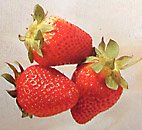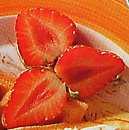Strawberries Nutrition facts
Delicious, rich-red, sweet, yet gently tangy strawberries are among the most popular berries. These berries are native to Europe, however, nowadays cultivated in many temperate regions all over the world as important commercial crops.
Botanically, the plant is a low-growing runner (creeper) belonging to the family of Rosaceae, in the genus: Fragaria.
Scientific name: Fragaria X ananassa.

|

|
| Strawberry-Fragaria X ananassa. Note green leafy cap at the crown end. | Cut sections- interior view. |
In botany, strawberry is described as an aggregate fruit, wherein many one-seeded achenes are coming together to form a large fleshy receptacle.
It is a small, low-lying, spreading shrub. It bears small white flowers, which eventually develop into small conical, light green, immature fruits. They turn red upon maturity, with each berry featuring red pulp and tiny, yellow seeds piercing from within through its surface. Its stem end carries a green leafy cap (calyx with peduncle) that is adorned as a crown.
Each berry features a conical shape, weighs about 25 grams, and measures about 3 cm in diameter. The berries have a taste that varies by cultivar type and ranges from quite sweet to acidic.
Although wild varieties are sometimes available in the market, large-scale production employs the modern "plasticulture" system. In this method, raised beds are formed each year, fumigated, and covered with plastic which prevents weed growth and crop spoiling.
Health benefits of Strawberries
Strawberry is low in calories (32 cal/100 g) and fats but a rich source of health-promoting phytonutrients, minerals, and vitamins that are essential for optimum health.
Strawberries have significantly high amounts of phenolic flavonoid phytochemicals called anthocyanins and ellagic acid. Scientific studies show that consumption of these berries may have potential health benefits against cancer, aging, inflammation, and neurological diseases.
Strawberry has an ORAC value (oxygen radical absorbance capacity, a measure of antioxidant strength) of about 3577 μ mol TE per 100 grams.
Fresh berries are an excellent source of vitamin C (100 g provides 58.8 mg or about 98% of RDI), which is also a powerful natural antioxidant. Consumption of fruits rich in vitamin C helps the body develop resistance against infectious agents, counter inflammation, and scavenge harmful free radicals.
The fruit is rich in the B-complex group of vitamins. It contains good amounts of vitamin B-6, niacin, riboflavin, pantothenic acid, and folic acid. These vitamins act as co-factors to help the body metabolize carbohydrates, proteins, and fats.
Strawberries contain vitamin A, vitamin E, and health-promoting flavonoid polyphenolic antioxidants such as lutein, zeaxanthin, and beta-carotene in small amounts. These compounds help act as protective scavengers against oxygen-derived free radicals and reactive oxygen species (ROS) that play a role in aging and various disease processes.
Furthermore, They contain a good amount of minerals like potassium, manganese, fluorine, copper, iron, and iodine. Potassium is an important component of cells and body fluids that helps control heart rate and blood pressure. The human body uses manganese as a co-factor for the antioxidant enzyme, superoxide dismutase.
Copper is required in the production of red blood cells. Iron is essential for red blood cell formation. Fluoride is a component of bones and teeth and offers protection from dental caries.
Please visit this page to view the infographic featuring strawberries nutrition facts per 100g: Strawberries nutrition infographic....
| Principle | Nutrient Value | Percent of RDA |
|---|---|---|
| Energy | 32 Kcal | 1.5% |
| Carbohydrates | 7.7 g | 6% |
| Protein | 0.67 g | 0.1% |
| Total Fat | 0.30 g | 1% |
| Cholesterol | 0 mg | 0% |
| Dietary Fiber | 2.0 g | 5% |
| Vitamins | ||
| Folates | 24 μg | 6% |
| Niacin | 0.386 mg | 2.5% |
| Pantothenic acid | 0.125 mg | 2.5% |
| Pyridoxine | 0.047 mg | 3.5% |
| Riboflavin | 0.022 mg | 2% |
| Vitamin A | 12 IU | 0.5% |
| Vitamin C | 58.8 mg | 98% |
| Vitamin E | 0.29 mg | 2% |
| Vitamin K | 2.2 µg | 2% |
| Electrolytes | ||
| Sodium | 1 mg | 0% |
| Potassium | 153 mg | 3% |
| Minerals | ||
| Calcium | 16 mg | 1.6% |
| Iron | 0.41 mg | 5% |
| Magnesium | 13 mg | 3% |
| Manganese | 0.386 mg | 17% |
| Zinc | 0.14 mg | 1% |
| Phytonutrients | ||
| Carotene-ß | 7 μg | -- |
| Lutein-zeaxanthin | 26 μg | -- |
Selection and storage
Strawberries can be available year-round in the stores but are fresh and plentiful from spring through mid-summer.
In the stores, choose berries that feature deep red with attached green caps, plump, shiny, free of sand and mold. Avoid those that appear dull, sunken, or flattened and those with signs of mold, cuts, or discolored patches on the surface. Unripe berries have green or yellow patches on their surface.
They perish early and therefore, should only be purchased a few days before use. Also, since strawberries cease to ripe after their harvest, avoid buying unripe berries as they often turn sour and unappetizing.
Before storing inside the refrigerator, sort out any damaged and those affected by mold so that they do not spread and contaminate healthy-looking ones. Place them in a wide bowl, or spread them out on a plate covered with a paper towel.
They keep fresh inside the refrigerator for a day or two. Use them as early as possible. For extended storage, place them in the freezer compartment.
Preparation and serving tips
To wash strawberries, dip them in cold water in a large bowl for a few seconds and swish gently a few times. It helps to remove any sand and insecticide/fungicide residues. Then, gently pat them dry using a paper towel or cloth. This method also helps berries bring back to normal room temperature and enriches their flavor and taste.
Remove stems and caps by simply snipping them off with your fingers or using a paring knife.
Here are some serving tips:
Sliced fresh strawberries can be a great addition to fruit or green salad.
They can be a great snack between meals. Dried strawberry slices can be added to muffins, pies, and cakes and are used in cereal flakes as a breakfast meal.
The berries are a popular addition to dairy products; as in strawberry flavored ice cream, milkshakes, smoothies, and yogurts.
Safety profile
Strawberry consumption may cause serious allergic reactions in some sensitized individuals. Some of the most common symptoms of strawberry allergy include swelling and redness of mouth, lips, and tongue, eczema, hives, skin rash, headache, runny nose, itchy eyes, wheezing, gastrointestinal disturbances, depression, hyperactivity, and insomnia. Individuals who suspect an allergy to them may want to avoid it. (Medical disclaimer).
≺≺ Back to Fruits from Strawberries. Visit here for an impressive list of all varieties of fruits with complete illustrations of their nutrition facts and health benefits.
≺≺ Back to Home page.
Further reading and Resources:
Refer Stanford School of Medicine Cancer information Page- Nutrition to Reduce Cancer Risk (Link opens in new window).